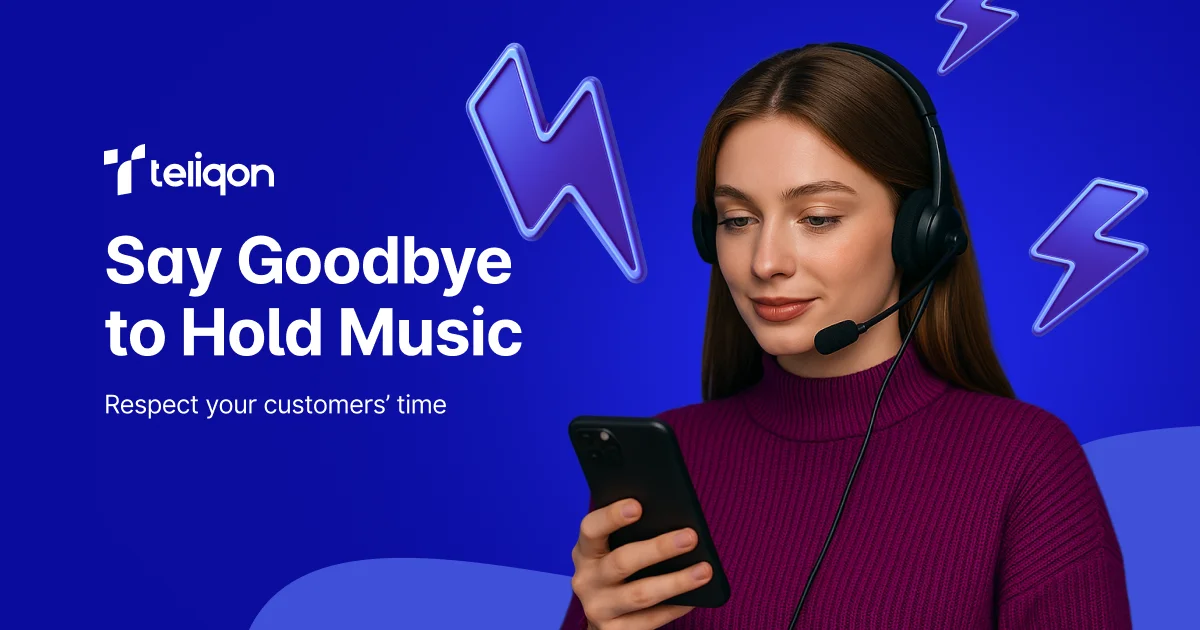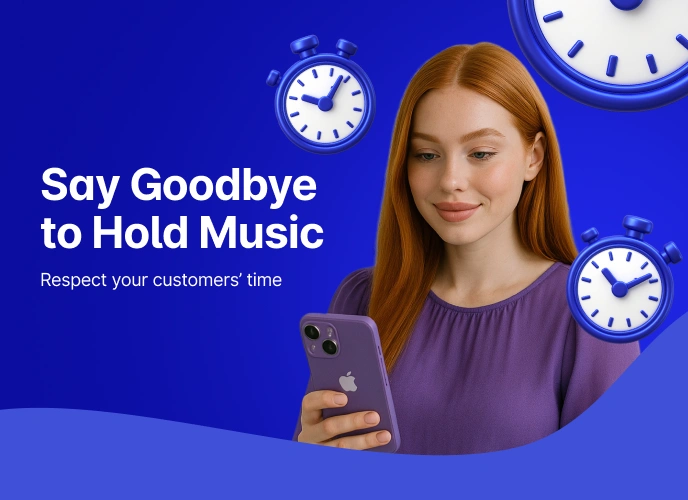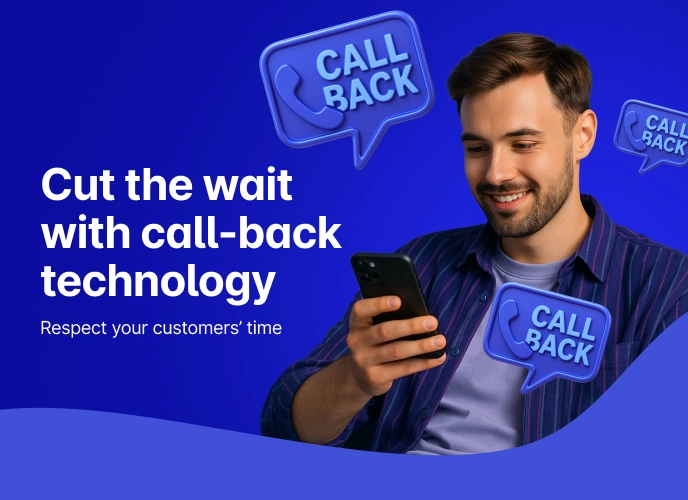

Oleh Romaniuk
July 30, 2025
How Intelligent Callbacks Slash Wait Times and Improve First-Call Resolution
Nothing frustrates a customer more than being stuck on hold, listening to an endless loop of elevator music. Long wait times are a major reason for customer churn and a significant drain on a company's resources. When customers finally do get through, the pressure is on for the agent to resolve their issue quickly and effectively on the first try. Without the right tools, achieving high first-contact resolution (FCR) can be a constant uphill battle.
But what if there were a way to virtually eliminate wait times and dramatically improve the efficiency of your customer service operations? The good news is, there is. Intelligent callback queues are transforming the customer service landscape, leveraging cutting-edge technology to offer callers a better experience. We're talking about a significant impact: studies and real-world implementations show that these advanced systems can reduce customer wait times by up to 32% and boost first-contact resolution efficiency by an impressive 75%.
In this article, you will discover how intelligent callback queues work, explore the core mechanisms that make them so effective, and see the tangible impact they're having on businesses today. We'll delve into best practices for implementation, examine the tools and technologies driving this revolution, and share compelling case studies. Finally, we'll discuss how to overcome common challenges, quantify the significant return on investment (ROI), and outline a clear path for getting started on your journey to superior customer service.
What are Intelligent Callback Queues?
Intelligent callback queues are advanced customer service systems that offer callers the option to receive a callback instead of waiting on hold. Unlike traditional callbacks, these systems integrate with call center AI software to not only hold a caller's place in line but also to intelligently route their return call to the most appropriate agent. This combination of queue management and AI in call centers fundamentally changes how customer interactions begin.
The core components of an intelligent callback queue system include:
-
Interactive Voice Response (IVR) – This initial touchpoint allows callers to select the callback option and sometimes provide a brief reason for their call, helping the system understand their needs.
-
Priority Queuing – The system doesn't just call back in sequence. It intelligently prioritizes callbacks based on factors like customer value, call reason, or urgency, ensuring critical issues are addressed sooner. This is a key feature of modern AI call center solutions.
-
AI-driven Scheduling – This is where call center AI truly shines. The system predicts optimal callback times by considering agent availability, forecasted call volumes, and the caller's stated preference. This ensures that when the system calls back, an agent is ready, minimizing further wait time. It's a prime example of call center automation AI improving efficiency.
Why They Work: Core Mechanisms
Intelligent callback queues are effective thanks to sophisticated mechanisms driven by call center AI technology. These systems optimize customer service beyond basic queuing.
-
AI-driven Prioritization – Instead of first-come, first-served, these systems use AI solution call center capabilities to prioritize. They analyze caller data, like history or the reason for the call, to route urgent or high-value cases faster. This ensures optimal resource allocation.
-
Dynamic Scheduling – A crucial element is the system's ability to dynamically schedule callbacks. It predicts and aligns callback times with agent availability and specific skill sets, monitoring agent loads in real time. This minimizes further customer wait time and is a hallmark of sophisticated AI in call center solutions.
-
CRM & Analytics Integration – Seamless integration with Customer Relationship Management (CRM) systems is vital. When a callback is initiated, relevant customer data is pulled and passed directly to the AI call center agent. This context prepares the agent, reducing repetitive questions and boosting efficiency. Real-time analytics also provide estimated callback times (ETAs) to customers.
Real‑World Impact: Hard Numbers
The benefits of intelligent callback queues are consistently demonstrated through measurable improvements across various key performance indicators (KPIs). These systems, leveraging advanced call center AI solutions, deliver tangible results that directly impact customer satisfaction and operational efficiency.
-
Wait Time Reduction – One of the most significant and immediate impacts is on customer wait times. Studies show a 32% drop in wait time, largely because callers are no longer tied to their phones. By offering a callback option, the perceived wait time is effectively eliminated, and the system ensures a timely connection when an agent becomes available. This significantly reduces the frustration traditionally associated with long holds.
-
First‑Contact Resolution Boost – Intelligent routing and pre-call data deliver a substantial increase in first-contact resolution (FCR). Thanks to smarter routing that matches callers with the best-suited agent, and agents being prepared with relevant customer context, FCR rates can climb by 75 percent. Agents spend less time gathering information and more time resolving issues efficiently, a clear outcome of effective call center AI automation.
-
Cost and Abandonment – The financial and operational benefits are equally compelling. With customers no longer facing lengthy holds, the rate of abandoned calls drops significantly. This not only prevents lost business opportunities but also reduces stress on agents who would otherwise deal with frustrated callers. Furthermore, by optimizing agent utilization and reducing inbound hold times, businesses can see notable cost savings in telecommunications and staffing. Fewer abandoned calls translate directly to better customer retention and a healthier bottom line.
Best Practices for Implementation
Implementing intelligent callback queues effectively requires strategic planning beyond simply installing AI call center software. To maximize their impact and ensure seamless operation, consider these best practices:
-
Threshold Rules – Set clear rules for when to offer callbacks. This usually involves defining thresholds based on anticipated or current wait times. For instance, if the estimated wait time exceeds a certain duration (e.g., two minutes), the system should automatically offer a callback option. This ensures customers are offered the convenience when they need it most—during peak times or unusually long queues.
-
UI/UX (User Interface/User Experience) – The customer experience must be intuitive. Provide clear, simple prompts within the IVR system for selecting the callback option. Offer choices for specific callback slots if possible, and always follow up with immediate SMS or email confirmations that include the estimated callback time and a reference number. Clarity and ease of use are paramount for customer adoption.
-
Skill-Based & Priority Routing – Leverage the system's call center voice AI capabilities to match callers with the best-suited agent. This means not just routing to the next available agent, but to an agent with the specific skills, expertise, or language proficiency required for the caller's issue. Combine this with priority routing rules that send high-value customers or urgent cases to the front of the queue, ensuring optimal handling.
-
Multi‑Channel Support – Intelligent callback functionality shouldn't be limited to voice calls. Extend the callback option to other channels, such as SMS, web chat, or even social media messages. A customer initiating a chat who faces a delay could be offered a voice callback, or vice versa, creating a truly integrated and flexible customer journey. This comprehensive approach enhances overall accessibility.
-
Analytics & Monitoring – Continuous monitoring and analysis are critical for optimizing the system. Track key metrics such as Average Handle Time (AHT), First-Contact Resolution (FCR) rates, callback abandonment rates, and Customer Satisfaction (CSAT) scores specifically for callback interactions. Use these insights to refine threshold rules, improve routing logic, and identify areas for agent training, ensuring the system continually improves.
Tools & Technologies
The advancements in intelligent callback queues are largely driven by sophisticated AI call center software and underlying AI modules. The competitive call center AI market offers a range of powerful tools designed to optimize customer interactions.
-
Major Providers – Several leading technology companies offer robust intelligent callback solutions as part of their contact center platforms. Prominent names include Dialzara, known for its comprehensive AI-driven contact center suite, Verint, which provides advanced customer engagement solutions, and Zendesk, recognized for its intelligent routing and service cloud capabilities. Other significant players in the market include Genesys, Five9, RingCentral, and Talkdesk, all of whom integrate AI to enhance call queue management and customer experience.
-
AI Modules – The intelligence within these systems comes from specialized AI modules that perform critical functions:
-
Sentiment Analysis – These modules analyze the emotional tone and content of customer interactions, often detected through call center voice ai during the initial IVR or live interaction. This helps prioritize urgent or frustrated callers, ensuring a more empathetic and timely response.
-
Wait-Time Prediction – Using historical data and real-time call center metrics, AI algorithms accurately predict future call volumes and agent availability. This allows the system to provide precise estimated callback times and dynamically adjust scheduling to minimize actual wait for the customer.
-
Adaptive Scheduling – This module goes beyond simple predictions. It continuously learns and adapts its callback scheduling based on actual outcomes, optimizing the timing of return calls to perfectly align with agent availability and skill sets. This ensures maximum efficiency and reduces agent idle time while simultaneously improving customer satisfaction.
Case Studies & Examples
The real-world impact of intelligent callback queues is best illustrated through the success stories of companies that have adopted these systems. These examples highlight how advanced technology translates into concrete business improvements.
-
Dialzara – A prominent provider in the contact center space, Dialzara consistently reports significant gains for its clients. Their AI call center software has enabled businesses to achieve a remarkable 32% drop in call abandonment rates. Furthermore, by intelligently routing calls and providing agents with comprehensive customer context, Dialzara's solutions have led to a 75% increase in first-contact resolution efficiency. This demonstrates how a comprehensive AI platform can tackle both customer frustration and operational inefficiencies simultaneously.
-
Zendesk / Netwealth – Australian financial services company Netwealth leveraged Zendesk's smart routing capabilities to revolutionize its customer service. Facing challenges with their legacy system, Netwealth implemented Zendesk's solution, which significantly reduced their call wait times. They reported achieving industry-leading call pick-up times, with their average time to resolution (TTR) dropping to an impressive 40–60 seconds. This case showcases how intelligent routing directly contributes to exceptional customer responsiveness in a demanding industry.
-
Additional Case Studies – The benefits extend across various industries with platforms like Sprinklr and Calilio. Companies utilizing Sprinklr for their customer experience management have reported improvements in response times and overall customer satisfaction through their configurable callback solutions. Similarly, Calilio highlights how its callback technology helps manage high call volumes, reduces abandonment rates, and increases agent productivity by ensuring customers receive timely callbacks when agents are available and prepared. These examples underscore the widespread applicability and proven effectiveness of intelligent callback systems.
Overcoming Challenges
While intelligent callback queues offer significant advantages, their successful implementation often involves navigating a few common challenges. Addressing these proactively is key to unlocking the full potential of these transformative systems.
-
System Integration – One of the primary hurdles is integrating the new intelligent callback system with existing, sometimes legacy, PBX (Private Branch Exchange) and CRM (Customer Relationship Management) platforms. Older systems may not have the necessary APIs or data compatibility for seamless communication. This can lead to data silos and hinder the intelligent routing capabilities. Overcoming this requires thorough planning, potentially phased implementation, and working closely with vendors to ensure robust data sync and interoperability.
-
Data Accuracy – The effectiveness of any AI-driven system, including intelligent callback queues, relies heavily on the quality and accuracy of the data it uses. Inaccurate or outdated customer records can lead to mis-prioritized callbacks, incorrect agent routing, or agents lacking crucial context, undermining the system's benefits. Maintaining up-to-date, clean records through regular data validation, automated updates, and clear data entry protocols for agents is essential.
-
Agent Training – Shifting from a traditional "always-on" inbound call flow to a scheduled callback workflow requires agents to adapt. They need training on how to manage scheduled callbacks, access pre-call context efficiently, and handle potential scenarios where a customer might not be immediately available for the callback. Comprehensive training programs, role-playing, and clear guidelines are crucial to ensure agents are comfortable and proficient with the new workflows, maximizing their efficiency and maintaining high service quality.
ROI & Business Value
The implementation of intelligent callback queues delivers a compelling return on investment (ROI) and significant business value. These systems transform customer service from a cost center into a strategic advantage by directly impacting profitability, efficiency, and customer loyalty.
-
Cost Savings – One of the most immediate financial benefits comes from reduced operational expenses. By eliminating long hold times, businesses save on telecommunication costs associated with extensive inbound call durations. Furthermore, the ability to smooth out call volume peaks and valleys through intelligent scheduling allows for more efficient staffing, reducing the need for overstaffing during anticipated surges and minimizing agent idle time during lulls. This leads to lower overall staffing costs and a more optimized budget.
-
Efficiency Gains – Intelligent callback queues drive substantial efficiency improvements across the contact center. The dramatic increase in First-Contact Resolution (FCR) means agents solve more issues on the first interaction, reducing repeat calls and follow-ups. Agents become more productive because they receive pre-qualified calls with full customer context, allowing them to focus on resolution rather than information gathering. This enhanced efficiency also contributes to improved agent morale, as they handle fewer frustrated customers and experience a more manageable workload, leading to higher job satisfaction and lower turnover.
-
Strategic Advantage – Beyond direct cost and efficiency, intelligent callback solutions offer a powerful strategic advantage. By prioritizing customer experience and respecting their time, businesses foster greater customer satisfaction (CSAT) and loyalty. Happy customers are more likely to become repeat buyers and recommend the brand, increasing customer lifetime value. In a competitive market, providing a superior service experience through intelligent callbacks differentiates a business, boosts its reputation, and drives sustained growth and competitiveness. It transforms customer service into a key driver of retention and cross-sell opportunities.
“Long holds drive frustration more than many admit – intelligent callbacks give back control to customers while freeing agents to engage when they can actually solve the issue. It isn’t enough to just reduce waiting; you have to pair that with smart routing and context so the very first contact also resolves the problem. When all that lines up, you see drops in abandonment, costs, and a real boost in satisfaction and loyalty.”

Oleh Romaniuk
Co-Founder at Teliqon
Conclusion
The era of endless on-hold music is ending. Intelligent callback queues, powered by AI, have transformed customer service from a point of frustration into a source of satisfaction and efficiency.
These systems use AI-driven routing and dynamic scheduling to virtually eliminate wait times. The results are clear: up to a 32% reduction in wait times and a 75% increase in first-contact resolution. This leads to fewer abandoned calls, lower costs, and increased customer loyalty.
While implementation requires addressing integration, data accuracy, and agent training, the strategic advantages and ROI are undeniable. By adopting a phased approach, businesses can achieve superior service.
Don't wait to improve your customer experience. Request a demo or start a Proof of Concept today.
The latest from Teliqon
Stay ahead with insights from the leader in trusted communications. Subscribe for the latest blogs, updates, and exclusive content.




